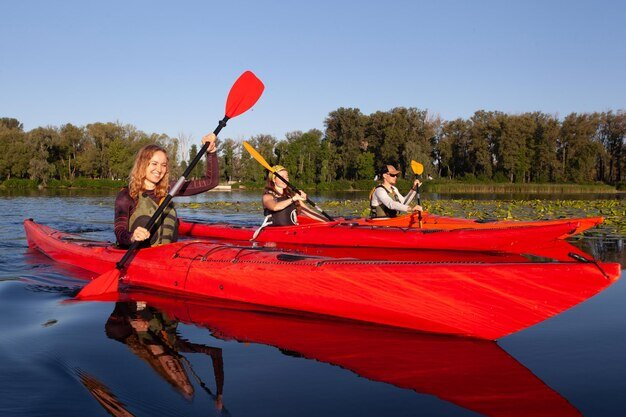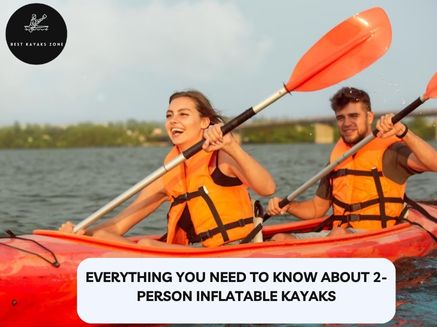
Tessa Young
Kayak Expert

John Smith
Expert Reviewed |Kayak Expert
Update
But what exactly makes a kayak stable? And more importantly, which design offers the ultimate stability you’re seeking? These questions plague many water enthusiasts, especially those new to the sport or looking to upgrade their gear. With countless kayak designs on the market, each claiming to be the most stable, it’s easy to feel overwhelmed and uncertain.
In this comprehensive guide, we’ll dive deep into the world of kayak stability. We’ll explore the factors that influence a kayak’s steadiness, examine different types of stability, and reveal the most stable kayak designs available. By the end, you’ll have the knowledge to choose the perfect stable kayak for your needs, ensuring your next water adventure is smooth sailing (or should we say, paddling!

On This Page
Factors Affecting Kayak Stability
Understanding the factors that influence kayak stability is crucial for both beginners and experienced paddlers. Let’s explore the key elements that contribute to a kayak’s overall stability on the water.
A. Hull Design
The hull design plays a pivotal role in determining a kayak’s stability. There are three main types of hull designs:
- Flat Hull: Offers excellent initial stability
- Round Hull: Provides better secondary stability
- V-shaped Hull: Enhances tracking and speed
Hull Type | Initial Stability | Secondary Stability | Speed |
Flat | High | Low | Low |
Round | Moderate | High | Moderate |
V-shaped | Low | High | High |
B. Width and Length
The width and length of a kayak significantly impact its stability:
- Wider kayaks generally offer more initial stability
- Longer kayaks tend to track better and provide more secondary stability
C. Weight Distribution
Proper weight distribution is essential for maintaining stability:
- Centered weight distribution enhances overall stability
- Evenly distributed gear and paddler weight improves balance
D. Materials Used
The materials used in kayak construction affect its stability:
- Heavier materials (e.g., polyethylene) can increase stability
- Lighter materials (e.g., fiberglass, carbon fiber) may require more skill to maintain balance
Now that we’ve covered the key factors affecting kayak stability, let’s explore the different types of stability in more detail.
Types of Kayak Stability
Understanding the different types of kayak stability is crucial for choosing the right kayak for your needs. Let’s explore the two main types of stability and how they affect your kayaking experience.
A. Primary Stability
Primary stability, also known as initial stability, refers to how stable a kayak feels when sitting still or moving in calm waters. This type of stability is particularly important for beginners and those who prefer a sense of security when first getting into the kayak.
Characteristics of high primary stability:
- Wider hull design
- Flatter bottom
- More resistant to tipping when stationary
B. Secondary Stability
Secondary stability, or final stability, is the kayak’s ability to resist capsizing when tilted on its side. This type of stability becomes crucial in rough waters or when performing advanced maneuvers.
Features of high secondary stability:
- Narrower hull design
- More rounded bottom
- Better performance in choppy conditions
C. Balancing Act: Primary vs. Secondary
Choosing between primary and secondary stability often involves trade-offs. Here’s a comparison to help you understand the differences:
Aspect | Primary Stability | Secondary Stability |
Hull Shape | Wider, flatter | Narrower, more rounded |
Best for | Beginners, calm waters | Experienced paddlers, rough waters |
Maneuverability | Less maneuverable | More maneuverable |
Speed | Generally slower | Generally faster |
Comfort for beginners | More comfortable | Less comfortable initially |
Now that we’ve explored the types of kayak stability, let’s look at some specific kayak designs that offer excellent stability for various purposes.
Most Stable Kayak Designs
Now that we’ve explored the factors affecting kayak stability and the different types of stability, let’s dive into the most stable kayak designs available. These designs prioritize stability without compromising on performance, making them ideal for various water activities and skill levels.
A. Sit-on-Top Kayaks
Sit-on-top kayaks are renowned for their exceptional stability, making them a popular choice among beginners and recreational paddlers. Their wide, flat hull design provides excellent initial stability, allowing users to feel secure and balanced on the water.
Key features of sit-on-top kayaks:
- Open deck design
- Self-draining scupper holes
- Wide, flat hull
- High weight capacity
B. Recreational Kayaks
Recreational kayaks are designed with stability and ease of use in mind. They typically feature a wider beam and flatter bottom, offering great initial stability for calm waters.
Characteristics of recreational kayaks:
- Shorter length (9-12 feet)
- Wide beam (28-34 inches)
- Large cockpit opening
- Comfortable seating
C. Fishing Kayaks
Fishing kayaks are engineered for maximum stability to accommodate the movements and gear associated with angling. They often incorporate additional features to enhance stability and functionality.
Stability-enhancing features in fishing kayaks:
- Wide, flat hull design
- Pontoon-style hulls
- Outriggers or stabilizers
- Standing platforms
D. Tandem Kayaks
Tandem kayaks, designed for two paddlers, offer increased stability due to their longer length and wider beam. The distribution of weight between two paddlers also contributes to improved stability.
Benefits of tandem kayaks for stability:
- Longer length (12-16 feet)
- Wider beam (30-36 inches)
- Balanced weight distribution
- Higher weight capacity
E. Inflatable Kayaks
Modern inflatable kayaks have come a long way in terms of stability and performance. Their design often incorporates multiple air chambers and a wide base, resulting in excellent stability on the water.
Advantages of inflatable kayaks for stability:
- Multiple air chambers
- Wide, flat bottom
- Flexible material adapts to water surface
- Lightweight and portable
To better understand the stability characteristics of these kayak designs, let’s compare them in the following table:
Kayak Design | Initial Stability | Secondary Stability | Best For |
Sit-on-Top | Excellent | Good | Beginners, recreational use |
Recreational | Very Good | Very Good | Calm waters, casual paddling |
Fishing | Excellent | Good | Anglers, stand-up fishing |
Tandem | Very Good | Good | Pairs, families |
Inflatable | Very Good | Good | Portability, versatility |
When choosing the most stable kayak design, consider your intended use, skill level, and the type of water you’ll be paddling in. Each design offers unique advantages, and the most stable option for you will depend on your specific needs and preferences.
Next, we’ll explore the specific features that can further enhance kayak stability, helping you make an informed decision when selecting your ideal watercraft.
Features Enhancing Kayak Stability
Now that we’ve explored different kayak designs, let’s delve into specific features that contribute to a kayak’s stability. These elements can significantly improve your paddling experience, especially for beginners or those seeking extra balance on the water.
Wider Beams
A wider beam, or the width of the kayak at its widest point, is one of the most effective ways to increase stability. Here’s why:
- Increased surface area on the water
- Better weight distribution
- Improved resistance to tipping
Beam Width | Stability Level | Best For |
< 23 inches | Low | Experienced paddlers, speed |
23-28 inches | Moderate | All-around use |
> 28 inches | High | Beginners, fishing |
Flat Bottoms
Kayaks with flat bottoms offer excellent initial stability, making them ideal for calm waters and beginners.
- Provide a stable platform
- Offer more predictable behavior on water
- Great for fishing and recreational use
Pontoons and Outriggers
For maximum stability, some kayaks feature pontoons or outriggers:
- Act as training wheels on water
- Dramatically increase stability
- Can be retractable for versatility
Adjustable Seats and Footrests
Proper positioning within the kayak is crucial for stability:
- Adjustable seats allow for optimal weight distribution
- Footrests help maintain balance and control
- Customizable setups accommodate different body types and paddling styles
By incorporating these features, kayak manufacturers can create designs that cater to various skill levels and intended uses, ensuring a stable and enjoyable experience on the water.
Choosing the Right Stable Kayak
Now that we’ve explored various stable kayak designs and features, let’s focus on how to choose the right one for you. Selecting a stable kayak involves considering several factors to ensure you get the perfect match for your needs and skill level.
A. Consider Your Skill Level
Your kayaking experience plays a crucial role in determining the most suitable stable kayak. Here’s a quick guide:
Skill Level | Recommended Kayak Type | Key Features |
Beginner | Sit-on-top or Recreational | Wide hull, flat bottom |
Intermediate | Touring or Day-touring | Moderate width, slight V-shape |
Advanced | Sea kayak or Performance | Narrower hull, pronounced V-shape |
B. Evaluate Your Intended Use
Different kayaking activities require varying levels of stability: Fishing: Opt for a wide, stable platform with ample storage
- Recreational paddling: Choose a kayak with good initial stability
- Whitewater: Look for kayaks with excellent secondary stability
- Touring: Balance between stability and speed is key
C. Test Before You Buy
Nothing beats hands-on experience. Before purchasing:
- Attend kayak demos
- Rent different models
- Ask for test paddles at local shops
D. Accessories for Added Stability
Enhance your kayak’s stability with:
- Outriggers or stabilizers
- Adjustable foot pegs
- Thigh braces
- Padded seats with good back support.
Remember, the most stable kayak is one that suits your needs and makes you feel confident on the water. Take your time to find the perfect match, and you’ll enjoy countless hours of safe and enjoyable paddling.
Conclusion
Choosing the most stable kayak design involves understanding various factors and considering your specific needs. From hull shapes to width and length, each element plays a crucial role in determining stability. Whether you prioritize primary stability for calm waters or secondary stability for rougher conditions, there’s a kayak design suited to your preferences.
Remember, the most stable kayak isn’t necessarily the best for everyone. Consider your skill level, intended use, and the type of water you’ll be navigating. By focusing on features like wider beams, flatter hulls, and additional stabilizing elements, you can find a kayak that offers the perfect balance of stability and performance for your kayaking adventures.
FAQS:
What is the safest style of Kayak?
The safest style of kayak is generally considered to be a sit-on-top kayak. These kayaks offer excellent stability and are easy to re-enter if you capsize. They’re ideal for beginners and those prioritizing safety on calm waters.
What is the hardest kayak to flip?
Wide, flat-bottomed kayaks are the hardest to flip. Specifically, recreational sit-on-top kayaks with a width of 30-34 inches are extremely stable and difficult to capsize. Their low center of gravity and wide hull design contribute to their stability.
What size kayak is the most stable?
The most stable kayaks are typically wider and shorter. A kayak between 10-12 feet long and 30-36 inches wide offers optimal stability for most paddlers. However, the ideal size can vary based on the paddler’s weight and intended use.
About Author

Tessa Young
Kayak Expert
Tessa Young is a highly experienced kayak expert with over 8 years of dedicated work in the kayaking industry. Her in-depth knowledge and passion for water sports make her a reliable source of information for kayakers of all levels. Tessa has extensively tested and reviewed a wide range of kayaks, offering expert advice to help readers make informed decisions. Her insights are valued by those looking for trustworthy recommendations on the best kayaks for various needs and environments.
Read More

John Smith
Expert Reviewed | Kayaks Expert
John Smith is an accomplished kayak reviewer with more than 12 years of expertise in evaluating kayak performance and quality. His thorough and unbiased reviews have made him a respected figure among kayaking enthusiasts. John’s extensive experience on the water enables him to provide detailed assessments, focusing on key aspects such as stability, speed, and durability. Readers can rely on John’s expert evaluations to guide them in choosing the right kayak for their adventures.
Read More



